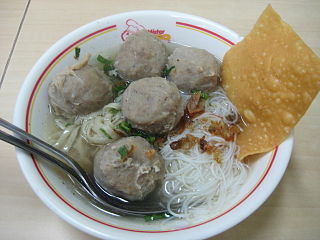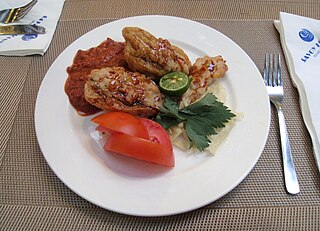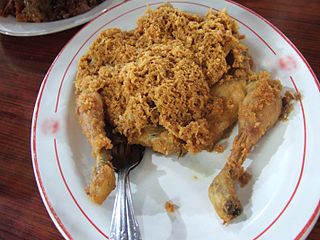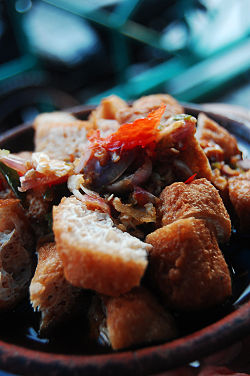
Satay, or sate in Indonesian spelling, is a Southeast Asian form of kebab made from seasoned, skewered and barbecued meat, served with a sauce.

Tahu goreng or Tauhu goreng is a generic name for any type of fried tofu dish in the cuisines of Indonesia, Malaysia and Singapore.

Chinese Indonesian cuisine is characterized by the mixture of Chinese with local Indonesian style. Chinese Indonesians, mostly descendant of Han ethnic Hokkien and Hakka speakers, brought their legacy of Chinese cuisine, and modified some of the dishes with the addition of Indonesian ingredients, such as kecap manis, palm sugar, peanut sauce, chili, santan and local spices to form a hybrid Chinese-Indonesian cuisine. Some of the dishes and cakes share the same style as in Malaysia and Singapore, known as Nyonya cuisine by the Peranakan.

Nasi goreng is a Southeast Asian fried rice dish, usually cooked with pieces of meat and vegetables. One of Indonesia's national dishes, it is also eaten in Malay-speaking communities in countries such as Malaysia, Singapore and Brunei, and has gained popularity in Sri Lanka through migrations from the Indonesian Archipelago, in countries like Suriname via Indonesian immigrant communities, and in the Netherlands through its colonial ties with Indonesia. Nasi goreng is distinguished from other Asian fried rice preparations by its distinct smoky aroma, and caramelised yet savoury undertones of flavour. There is no single defined recipe for nasi goreng, and its composition and preparation varies greatly from household to household.

Siomay, is an Indonesian steamed fish dumpling with vegetables served in peanut sauce. It is derived from the Chinese Shumai. It is considered a light meal, similar to the Chinese Dim Sum. It is traditionally made from pork but is frequently substituted with tenggiri, as many Indonesians observe the halal dietary law. Sometimes other types of seafood such as tuna, mackerel, and prawn also can be used to make siomay. Other complements to siomay include steamed cabbage, potatoes, bitter gourd, boiled egg, and tofu. Siomay is often cut into bite size pieces and topped with peanut sauce, sweet soy sauce, chili sauce and a dash of lime juice.

Bakso or baso is an Indonesian meatball, or a meat paste made from beef surimi. Its texture is similar to the Chinese beef ball, fish ball, or pork ball. The word bakso may refer to a single meatball or the complete dish of meatball soup. Mie bakso refers to bakso served with yellow noodles and rice vermicelli, while bakso kuah refers to bakso soup served without noodles.

Pempek, mpek-mpek and also known as colloquially as empek-empek is a savoury Indonesian fishcake delicacy, made of fish and tapioca, from Palembang, South Sumatera, Indonesia. Pempek is served with rich sweet and sour sauce called kuah cuka or kuah cuko, or just "cuko". Sometimes local people also eat the dish with yellow noodles and diced up cucumber to balance out the vinegar's sourness.

Lontong is an Indonesian dish made of compressed rice cake in the form of a cylinder wrapped inside a banana leaf, commonly found in Indonesia, Malaysia and Singapore. Rice is rolled inside a banana leaf and boiled, then cut into small cakes as a staple food replacement of steamed rice. The texture is similar to those of ketupat, with the difference being that the ketupat container is made from woven janur fronds, while lontong uses banana leaf instead.

Javanese cuisine is the cuisine of Javanese people, a major ethnic group in Indonesia, more precisely the province of Central Java, Yogyakarta and East Java.

Ketoprak is an Indonesian vegetarian dish from Jakarta, consisting of tofu, vegetables, rice cake, and rice vermicelli served in peanut sauce.

Sundanese cuisine is the cuisine of the Sundanese people of Western Java, and Banten, Indonesia. It is one of the most popular foods in Indonesia. Sundanese food is characterised by its freshness; the famous lalab eaten with sambal and also karedok demonstrate the Sundanese fondness for fresh raw vegetables. Unlike the rich and spicy taste, infused with coconut milk and curry of Minangkabau cuisine, the Sundanese cuisine displays the simple and clear taste; ranged from savoury salty, fresh sourness, mild sweetness, to hot and spicy.

Batagor is a Sundanese dish from Indonesia, and popular in Southeast Asia, consisting of fried fish dumplings, usually served with peanut sauce. It is traditionally made from minced tenggiri, although other types of seafood such as tuna, mackerel, and prawn may also be used. The fish paste is subsequently stuffed into wonton skins or filled into tofu, and then deep fried in palm oil.

Nasi lengko in Indonesian, Lengko rice in English) is a typical Cirebonese dish in Cirebon, Indramayu, Brebes, Tegal and surrounding areas.

Betawi cuisine is rich, diverse and eclectic, in part because the Betawi people that create them were composed from numbers of regional immigrants that came from various places in the Indonesian archipelago, as well as Chinese, Indian, Arab, and European traders, visitors and immigrants that were attracted to the port city of Batavia since centuries ago.

Lumpia are various types of spring rolls commonly found in Indonesia and the Philippines. Lumpia are made of thin paper-like or crepe-like pastry skin called "lumpia wrapper" enveloping savory or sweet fillings. It is often served as an appetizer or snack, and might be served deep-fried or fresh (unfried). Lumpia are Indonesian and Filipino adaptations of the Fujianese rùnbǐng and Teochew popiah, usually consumed during Qingming Festival.

Ayam goreng is an Indonesian and Malaysian dish consisting of chicken deep fried in oil. Ayam goreng literally means "fried chicken" in Malay, Indonesian and also in many Indonesian regional languages. Unlike other countries, Indonesian fried chicken usually does not use flour as its main ingredients, instead it uses turmeric and garlic as its main ingredients.

Gado-gado is an Indonesian salad of raw, slightly boiled, blanched or steamed vegetables and hard-boiled eggs, boiled potato, fried tofu and tempeh, and lontong, served with a peanut sauce dressing.

Tauge goreng is an Indonesian savoury vegetarian dish made of stir-fried tauge with slices of tofu, ketupat or lontong rice cake and yellow noodles, served in a spicy oncom-based sauce. Tauge goreng is a specialty of Jakarta and Bogor city, West Java, Indonesia. It is usually sold as street food using pikulan or gerobak (cart) by street vendors. It is a popular street food in Indonesia, especially in Jakarta, and Greater Jakarta areas, including Bogor, Depok, Tangerang and Bekasi.

Tahu campur, literally meaning "mixed tofu" in Javanese language and broader Indonesian language, is an East Javanese tofu dish. The dish consists of sliced tahu goreng, lontong, lentho or sometimes replaced by perkedel, fresh bean sprouts, fresh lettuce, yellow noodles, and krupuk crackers, served in savoury beef stew, garnished with fried onions, and sambal chili sauce. The beef stew soup is seasoned with spices and petis, a type of shrimp paste commonly used in East Javanese cuisine.

Indonesian noodles are a significant aspect of Indonesian cuisine which is itself very diverse. Indonesian cuisine recognizes many types of noodles, with each region of the country often developing its own distinct recipes.





















